Cycas Revoluta
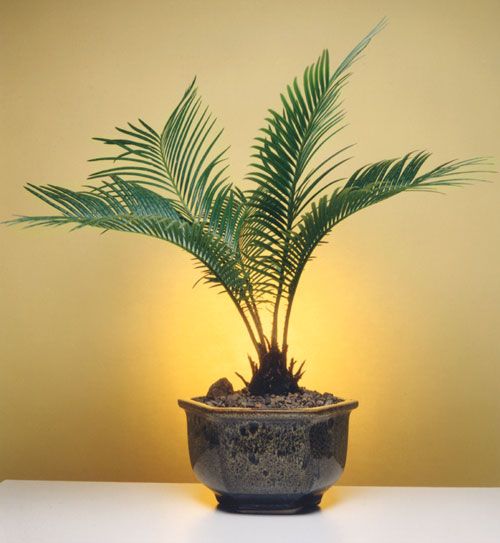
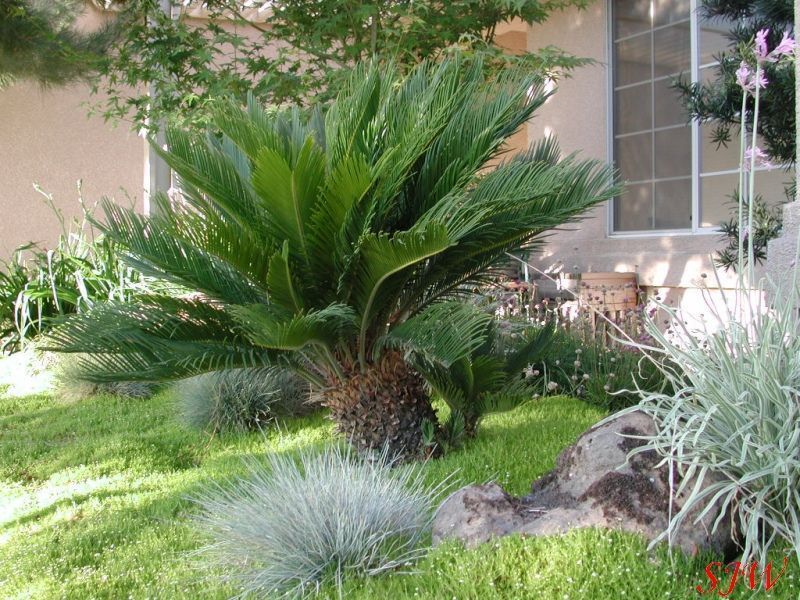
Common Names: sago palm, Japanese sago palm, funeral palm
Family: Cycadaceae
Origin: Japan's southern islands
Height: 10" - 12" tall
Description
This is a very interesting plant that has been around since the time of the dinosaurs, during the Mesozoic era, over 150 million years ago. Today about 10 genera of cycads still survive. The most commonly grown is the Japanese sago, also called the sago palm (even though it isn't really a palm). It's unique shape and texture provide interest in both the landscape and indoors.
This very symmetrical plant supports a crown of shiny dark green leaves on a thick shaggy trunk that can grow to 10-12 ft (25.4-30.5 m) high. The plant is very slow gowing requiring about 50 years to achieve this height. As the plant matures branching of the thick stem may occur which only adds to the interest and charm of this beauty. Japanese sago also tends to produce suckers at its base forming a large multi-stem clump over time.
The distinctive leaves grow 4-5 ft (10.2-12.7 m) in length and are about 9 in (22.9 m) in width. Leaves are pinnate and are composed of a rigid midrib with glossy leaflets arranged in a plane along its length. These leaflets are revolute which means that they curl under along their edge - this attribute provides the plant's species name (C. revoluta). The sago is most attractive when the new leaves appear in late spring or early summer. They emerge as light green spikes, arranged in a circle around the perimeter of the trunk. They slowly uncoil growing to the ultimate length of the leaf. Then, in a graceful choreography, the individual leaflets unroll away from the midrib and the whole column of new leaves relaxes into a rosette that sits just above the existing crown of leaves.
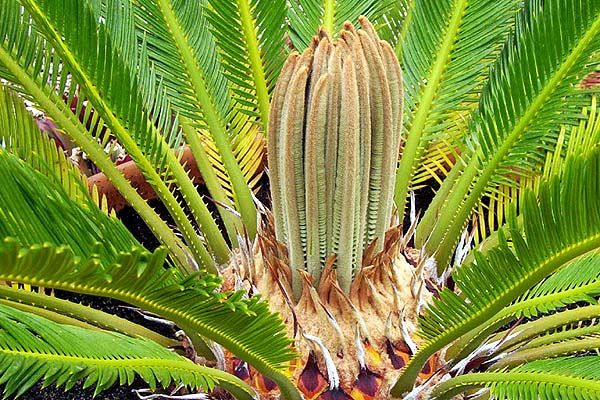
Care and cultivation
The Sago Palm is a long-lived exotic palm that tolerates neglect but thrives with attention. Adapts to indirect light or full sun and has a wide temperature range from 15 to 120 degrees F. A slow growth rate allows indoor speciments to remain in the same container indefinetely.
Treat as a cactus -- water when almost dry and seldom fertilize.
New leaves emerge all at once in a circular pattern, and are very tender until they begin to harden several weeks later. Do not disturb or repot the plant during this process and allow the plant to receive good overhead light; low light will produce long leaves, while bright light will produce shorter leaves. If light is coming from a window, give the plant a 1/4 turn each day until the new leaves harden, otherwise they may lean toward the light source. Do not allow the plant to become excessively dry when new leaves are developing, otherwise new foliage may wither and die or become yellow and stunted.
Temperature range is from 15 to 110 degrees F (-11 to 42 C). Temperatures in the high teens may frost-damage leaves which may turn yellow or brown. Remove these to reduce stress on the plant and encourage new leaves in the spring. If temperatures fall below 15, the sago may die, however, as long as the trunk and leaf crown is hard wood, it should recover. If the trunk turns soft, your sago may be damaged beyond recovery.
Humidity range is from dry to wet.
Light: Sagos grow in full sun, but adapt to outdoor shade or an indoor area which receives bright light or a few hours of morning or afternoon sun.
Rate of growth is extremely slow. The fastest rate observed in South Texas commercial production (which has excellent growing conditions of hot summers and mild winters) under 30% shade is three new sets of leaves and an increase of 1" (3 cm) of height and trunk diameter per year. When grown as potted indoor specimens, Cycads may add only one set of new leaves every year or two and remain somewhat the same size (one reason they are excellent for bonsai).
Longevity: Cycas revoluta are extremely long lived and old specimens can grow in curious ways.
Soil should be well drained and rich in humus, although these durable plants seem to grow in almost anything. In the landscape or garden, be sure to plant Sagos slightly above the soil line and not in a hole or depression which retains water or is "swampy". Sagos much prefer to be on the dry than the wet side.
Water and fertilizer needs are related to the amount of light available. Unlike most plants which can wilt when dry or turn yellow from lack of fertilizer, Cycads give little indication of when to water or feed. Generally, they should be treated as a cactus and watered when almost dry.
Watering: If grown in a container, allow the soil to become almost dry, then water thoroughly slowly adding water around the top of the soil. If the plant is receiving morning or afternoon sun or temperatures are warm, Sagos may need to be watered at least weekly. Plants grown in low light or cool temperatures may need water every few weeks or so. If planted in the landscape, water when dry, but do not keep continuously wet. Established plants can easily survive drought conditions.
Fertiliser is generally applied during spring and late summer. Sagos growing in partial sun should receive an average rate as listed on the container, those in low light should receive only 1/4 rate. Too little plant food is far better than too much. If organic or slow release fertilizer is used, do not allow any to fall into the plant crown which is protecting the formation of future leaves.
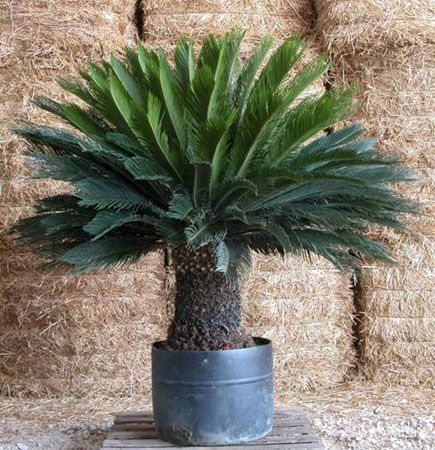 |
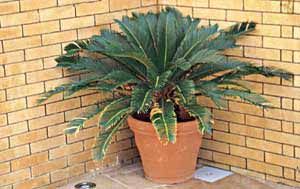 |
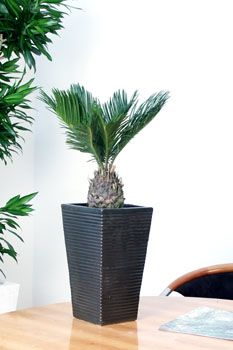 |
Propagation
By seed or removal of offsets called "pups".
Soak seed in water for several days, then remove the red skin, but leave the white hard seed coat. They can be planted immediately, or retained in a cool, dry place until March or April. Plant seed sideways, with only the top edge exposed, in well drained soil and keep soil moist but not soggy. Seed will usually germinate in 3-9 months, but may require more than three years of growth to reach a small bulb size 1" in diameter.
Offsets or "pups", growing at the base or along the sides of mature Sagos, are an excellent source of new plants. Remove them in early spring, late fall, or winter by using a hand trowel to pop small ones from the trunk side, or a sharp-shooter shovel to dig and gently crow-bar large ones from the base of the plant. Remove all the pups' leaves and roots, then set them aside for the raw spot to dry for a week or so. Plant in well-drained soil or a sandy mixture so that half the ball or trunk is below soil level - water thoroughly. Allow the soil to become nearly dry before watering. It's best to start new pups in a shady area or a bright indoor area. Roots will slowly begin to form and the first leaves appear several months later. At that time, apply a mild dose of fertilizer and water when almost, but not completely dry. Allow the new plants to form a good root system before repotting into a larger container or planting in your garden or landscape.
Pests and diseases
Old leaves may turn yellow from over watering or too much fertilizer.
New leaves may turn yellow from excess fertilizer or poor soil conditions.
Note: Once leaves turn yellow or brown, they should be removed from the plant.
Insects are limited to scale (can form a white or gray crust) or occasional attacks of mealy bugs. Use an insecticidal soap or a product labeled for scale. In all cases, use caution and follow the directions on the container. Always water a plant before treatment or spraying during the coolest part of the day or morning. The combination of heat, direct sun, and insecticide can burn leaves.
Articole asemănătoare
-
Si palmierii sufera din pricina arsitei
Atunci cand aerul devine foarte uscat si frunzele palmierilor incep sa se usuce sau prezinta pete ingalbenite ori uscate, trebuie luate masuri rapide de combatere a efectelor arsitei
-
Expozitie florala in Parcul Herastrau
In Parcul Herastrau s-a desfasurat intre 16 si 18 mai una din din cele cateva expozitii anuale de plante si flori, la intrarea Charles de Gaulle, pe o intindere de cateva sute de metri patrati.
-
Cycas C. Revoluta
Planta adulta prezinta un trunchi cilindric, gros, cu cicatrici si resturi de frunze imbatranite. La tinerete frunzele sunt colorate verde stralucitor, foarte lungi si frumos arcuite, compuse din numeroase foliole, cu asezare penata. Aceste plante nu infloresc niciodata in conditii de camera.
-
Gradina Chinezeasca din Portland
In urma unei idei rasarite in 1985 a luat fiinta, in septembrie 2000, Gradina Chinezeasca din Portland, sau Lan Su Yuan (Gradina Orhideelor Trezite). Gradina este amenajata in stilul dinastiei Ming, cu alei lungi, poduri...
-
Cycas revoluta
Denumiri populare: palmier sago, sagotierul japonez Familie: Cycadaceae Origine: insulele din sudul Japoniei Inaltime: 25-30 m